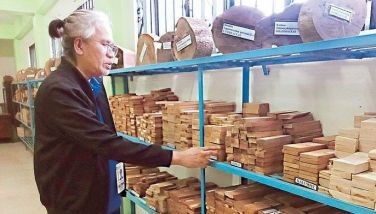Ave Marina: Tracking the seabirds of Tubbataha
MANILA, Philippines – 5:30 a.m. Under an overcast sky, a maddening cacophony of birdcalls served as our alarm clock.
We are bivouacked on the cold, wet sand of Tubbataha North Islet, a UNESCO World Heritage Site and one of Asia’s great seabird enclaves. I reluctantly turn my sleepy gaze to a backlit sky swarming with birds. North Islet’s residents have awakened – time for us to get moving.
Led by Danish ornithologist Dr. Arne Erik Jensen, we have been tasked to assess the seabirds of Tubbataha North and South Islets, part of an annual move by WWF (World Wildlife Fund) and the Tubbataha Management Office (TMO) to maintain and restore bird populations in the Sulu Sea. Our survey team finished with South Islet two days ago. This was our last day on the North Islet.
At the heart of the Coral Triangle are the twin atolls of Tubbataha, 160 kilometers (99 miles) southeast of Puerto Princesa City in Palawan and administered by nearby Cagayancillo. These are the largest coral atolls in the Philippines, each one emerging above the Sulu Sea. Famous for the wealth of its marine life and now a leading candidate for the New Seven Natural Wonders of the World, Tubbataha is equally important as one of the last great seabird rookeries of Southeast Asia.
Before the Second World War, seabirds were common throughout Southeast Asian islands. But 60 years of extensive human encroachment and marine pollution have taken their toll.
“Most face nothing less than local extinction, their former range reduced to a few isolated holdouts like Tubbataha North and South Islets. Birds here are able to breed freely because the lack of freshwater bars the intrusion of predators like cats, rats and people. Fortunately the area is protected by isolation and by good management from the TMO,” explains Jensen as the team gathers for the dawn briefing.
The team, composed chiefly of TMO Park Rangers and volunteers, is being split into pairs and tasked to either tag birds or count nests. I partner with Nick Molina, a weather-beaten Navy man serving the first of his three-month tour as a Park Ranger.
“Your job is to find nests of the Black Noddy, an endemic bird which breeds only here in Tubbataha. Look for cup-like leaf nests on trees and in low bushes,” instructs Jensen, glancing skyward. We know we must work quickly since North Islet heats up – fast. Adds Jensen with a grin, “Last survey, I found my partner passed out in some low bushes, totally delirious from heatstroke.”
Life above the sea
The first seabirds developed during the Cretaceous period, roughly 65 million years ago, when Tytthostonyx glauconiticus soared above Triceratops, Tyrannosaurus rex and other dinosaurs of that era. Today’s sea and shorebirds are perfectly adapted to life on the open ocean.
Over millions of years, evolution has gifted them with such useful traits as waterproof plumage and the ability to drink seawater. They inhabit remote areas and give birth to few young, which are tended to with great dedication.
Introduction of predators remains the greatest threat to seabirds. Isolated for centuries in inaccessible roosts, most have lost their natural defense mechanisms. After cats were introduced on Ascension Isle in the South Atlantic over a century ago, bird numbers dropped from 20 million to 400,000. Other threats include marine pollution, hunting and land development.
Over a hundred bird species regularly visit Tubbataha, and eight have been known to breed locally: the Red-footed Booby (Sula sula), Brown Booby (Sula leucogaster), Black Noddy (Anous minutus sub. worcestri), Brown Noddy (Anous stolidus), Great Frigatebird (Fregata minor), Great Crested Tern (Sterna bergii) and Sooty Tern (Sterna fuscata). Sadly, Masked Boobies (Sula dactylatra) were declared regionally extinct in 1995.
By the tree line, we catch glimpses of our quarry: resembling black pigeons, dozens of Black Noddies flit in and out of a Pisonia bush. We approach slowly, careful not to disturb the area any more than necessary. In contrast to the larger and more common Brown Noddy, which nests on shallow scrapes on the ground, the Black Noddy roosts exclusively on trees and in bushes. Both nests are easy to spot since the birds now use scavenged plastic junk for bedding.
“Five nests up on that branch,” points keen-eyed Nick and we quickly work out a system, quietly rummaging through trees and bushes plastered white with rank-smelling guano. We count 1,108 nests and 3,390 birds before the sun reaches its zenith. By a large open area known as the Plaza we notice the Brown Booby group tagging juveniles and inspecting nests. A meter away, other Boobies look on impassively.
At the debriefing an hour later, a sun-kissed Jensen abruptly points out a distant speck in the sky. “That’s the critically endangered Christmas Island Frigatebird, not officially recorded in the Philippines but seen here for years.” By day’s end we count a grand total of 19,617 birds, an improvement from last year’s 8,743 and akin to the 18,001 counted in 2006.
It is estimated that from March to November, over 30,000 seabirds roost on Bancoran, Cawili, Manuk-Manukan and other islands of the Sulu Sea, the main hub being Tubbataha. Notes Jensen, “This is a good number, an indicator of the health of these islands since in order to breed, seabirds need unspoiled habitats with an abundant supply of food like clams, squid and fish.”
Island ecosystems display nature’s balance
In 1911, American naturalist Dean Worcester first set foot on Tubbataha’s North Islet, now also called Bird Isle. It was then a barren sandy isle of 60,000 sq.m. Less than a century later the same area has shrunk to 17,000 square meters – but hosts almost a hundred trees, mostly Argusia and Pisonia. Remnants of invasive ipil-ipil trees, planted a generation ago by fishermen and extirpated by TMO, dot the scrubby landscape. There’s very little elevation, the highest point a mere two meters above sea level. At any time, 7,000 to 15,000 seabirds call this home.
In contrast, Parola or South Islet is much smaller, at 2895 sq.m. Most noticeable is a solar-powered lighthouse erected by the Philippine Coast Guard in 1980 to replace an ancient one constructed in 1938. A meter-high concrete wall, cracked and pitted by the elements, forms a protective ring against erosion. About 20 mature trees, crammed full of Black and Brown Noddies, dot the grassy landscape. East of the lighthouse is the rusting hulk of the Del San, an old log carrier.
Both islands are completely off-limits, save for the once-yearly bird census – a thought that has me grinning like an imp.
“These islands are always changing, as if they’re alive. Years ago, land area in both isles was much more extensive. “That spot,” points Tubbataha Park Manager Angelique Songco to what I can only guess was the sea, “was part of North Islet last year. The sand shifts, depending on the strength of the Sulu Sea currents. And should water levels rise from climate change, this whole place,” Songco sweeps her arms outwards, “will definitely go under.”
Both of Tubbataha’s isles are composed mostly of powdery white sand, but trees are still able to root, providing shelter for many birds. Then again, a purely tree-dominated island robs many ground-breeding birds like Brown Boobies and Terns of their nesting sites. “That’s why we cleared North Islet of ipil-ipil,” explains Songco, “Before, the Plaza was full of them – and Brown Boobies couldn’t find a place to nest.”
Battered by strong winds, the unrelenting sun and reflected heat from the sand, many trees are understandably in bad condition. Some are totally denuded, the remaining foliage damaged and coated with layers of guano. Though generally bad for coral reefs, droppings fertilize coastal seagrass beds which provide food for fish, sea cows and green turtles. The problem isn’t so much the presence of guano but an overload of it. Too much fertilizer prevents efficient photosynthesis and burns leaves and roots – displaying the delicate balance of nature.
The day’s survey done, we cool off in the clear blue waters of the lagoon, welcoming the occasional Green Sea Turtle and nervously eyeing a few intimidating but fairly harmless Blacktip Reef Sharks. Like the Plaza Boobies they are completely unafraid, knowing perhaps that the next time they’ll see people will be in a year’s time.
The future of seabirds
Seabirds are instrumental in combating climate change, particularly the threat of rising sea levels, by indirectly developing island ecosystems.
They provide vital fertilizer for nutrient-poor sandbars, allowing the first waves of pioneer plants to survive. Drifting in from nearby isles, seeds of trees eventually take root – further binding the sand, increasing land size and trapping organic sediments – the first steps in producing soil. Enough trees eventually cover the island that rainwater begins to accumulate, making it habitable for other animals and people.
Fossilized bird droppings also form Phosphorite, a type of rock used for agricultural fertilizer. Phosphorite deposits have for centuries been mined on small islands and is now of great value for food production.
Before it was declared a National Marine Park in 1988, Tubbataha’s residents had long suffered from exploitation, with generations of fishermen gathering not just fish, but turtles and bird eggs as well.
“As Southeast Asian seabird populations continue to decline due to habitat encroachment, pollution and illegal hunting, the many benefits derived from them will diminish. Only through constant vigilance can we hope to sustain them,” says WWF-Project Manager Marivel Dygico. TMO and WWF have protected the isles for years, keeping bird populations in check and human intrusion to a minimum. Adds Dygico, “But here in Tubbataha they’ll always be free to live and breed.”
Back at our ship, the M/B Minerva, Arne and I regard a horizon overcast with rain clouds – heralding the arrival of a huge typhoon and changing climate, the amihan (northeast) and habagat (southwest) winds still months off.
“Let me tell you a sad story, that of Bancauan Isle,” he says quietly. “When people first settled, there were birds all around. But the people brought with them rats, dogs and cats. In a few years all the ground-breeding seabirds were wiped out… few even remember they existed.”
I fail to respond, knowing full well that left unprotected, the same fate might well befall Tubbataha. Indeed the future of Southeast Asia’s seabirds seems as precarious as the island ecosystems they inhabit, dependent on their isolation and on continuous human protection to survive. Off in the distance we make out a gliding shadow – a rare Bulwer’s Petrel as it hunts for fish.
As the first raindrops fall, the Petrel majestically circles round, then soars south, back to Tubbataha. We watch it for a long time.
The author is the information, education and communications officer of World Wildlife Fund (WWF)-Philippines.
- Latest
- Trending






























